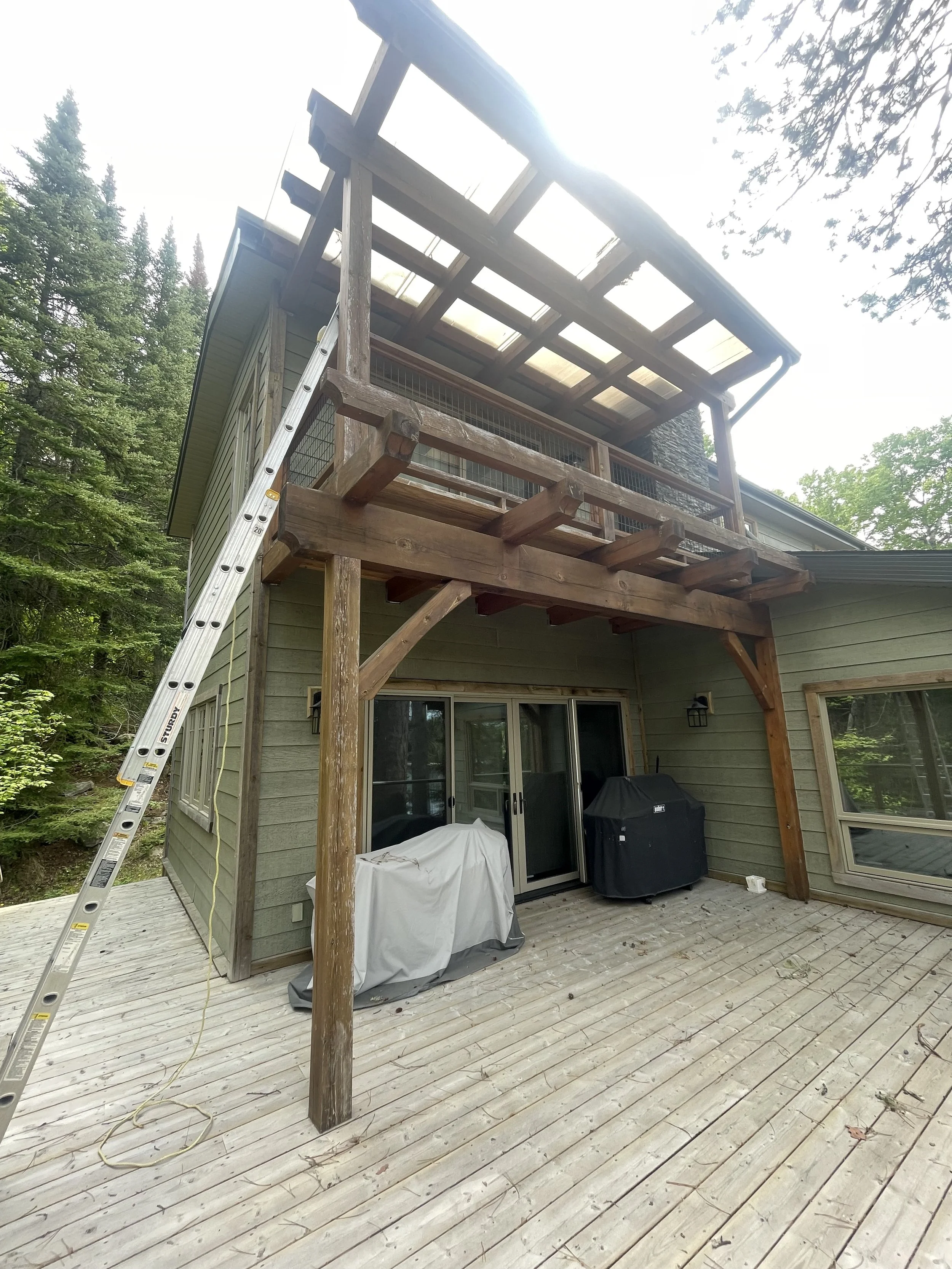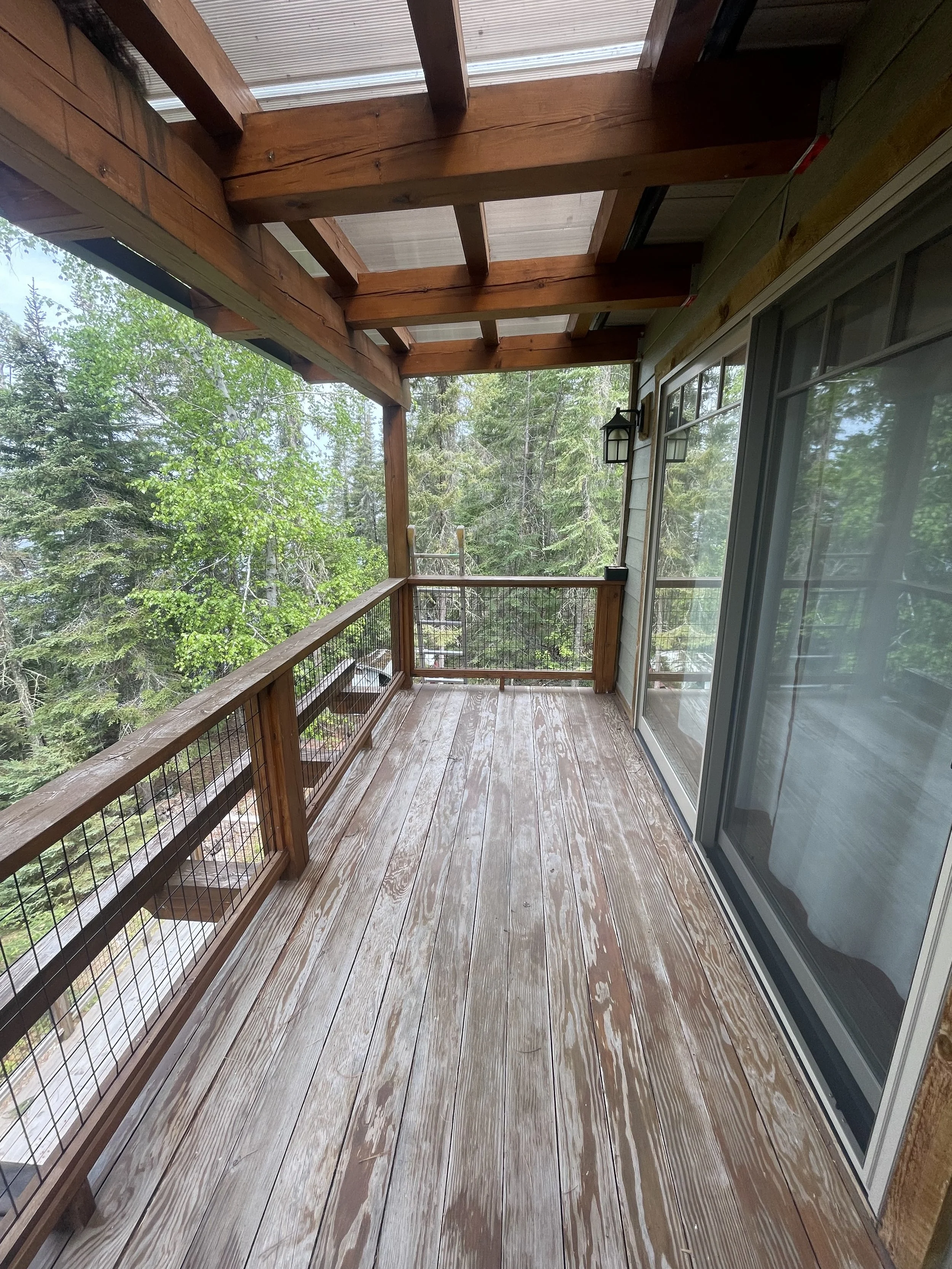This post is a review of a recent timber frame restoration project we completed in Lac du Bonnet, Manitoba — a beautiful timber home right on the lake.
As a Manitoba company specializing in timber frame and log home maintenance, this project highlights many of the common issues we see with clear coats, UV exposure, and weathered wood.
Initial Condition: Clear Coat Without Stain
The situation here was that the timbers were originally finished with a tinted clear coat—but not a proper stain.
This resulted in:
Weathering beneath the clear coat
Grain discoloration
Areas where the clear coat deteriorated
Patchy, uneven tones throughout the timber
Blackened and greyed fascia and outward-facing beams
In many spots, the clear coat had failed, but in others it remained intact while the wood underneath aged and discoloured.
Visible Signs of Weathering
On the lakeside especially, the beams showed:
Random discoloration and dappling
Grey and black weathering
Darkened zones where UV damage went deeper into the wood
Areas where the clear coat stayed intact but the wood beneath aged unevenly
The driveway side had similar blackening and grain aging. Up close, the inconsistencies were even more visible.
Our Approach: Sanding, Blending, and Restoring
We began by sanding down the fronts and sides of the most exposed timbers to remove the damaged finish and access the raw wood.
Some lighter spots remained — this is normal, since certain parts of the grain weather deeper and can’t be eliminated entirely.
Timbers closer to the soffits didn’t need sanding because they hadn’t received the same level of sun exposure, so they were still in good condition.
The goal here wasn’t to make everything look brand new — that’s not realistic with natural wood.
Instead, we aimed to create a cohesive, naturally aged look that blends well and is easier to maintain long-term.
Scaffolding, Lifts, and Prep Work
We set up scaffolding and lifts to access the top peak and higher beams.
You can see the color shifting even in the early stages as the sanding and first coats of stain went on.
Lower timbers began receiving their first coats, helping them blend into the surrounding materials and soffits.
Again, you’ll see that stain takes darker in certain zones — especially around knots or deeper grain patterns. This is completely natural and tends to soften over a few weeks.
Sanding Results and Exposing Fresh Wood
As sanding progressed, we exposed clean wood underneath.
This raw wood still showed some natural grain artifacts — which can’t always be removed — but the drastic grey and black weathering was eliminated.
These variations are part of the character of timber frames, and once stained and sealed, they create a much more natural, cohesive appearance.
Applying Stain and Clear Coat
Once the sanding was complete, we applied:
A tinted stain to deepen and unify the tone
One or two coats of clear coat for protection
Important note:
Stain = UV protection (think sunscreen)
Clear coat = moisture barrier (think rain jacket)
Each has a different purpose, and both are essential for long-term timber maintenance.
Darker stain tones also help mask future weathering while adding additional UV resistance.
Final Results: A Cohesive, Protected Timber Frame
The final look brought everything together:
A more uniform tone across all timbers
Front-facing beams restored to a natural, rich appearance
Aging artifacts minimized
Clear protection added for longevity
A finish that’s 80–90% back to how it would have looked when new
It won’t ever look brand-new again — that’s simply the nature of wood — but the transformation was significant.
The home now has a finish that is easier to maintain and far more resistant to future sun and weather exposure.
Project Recap
This project involved:
Extensive sanding of sun-exposed timbers
Blending techniques to match existing protected wood
Application of stain for color and UV protection
Clear coat to seal and protect
Scaffolding, lifts, and multi-angle access work
A full restoration of the timber frame’s natural beauty
It was a big transformation and a fun project to work on.



















